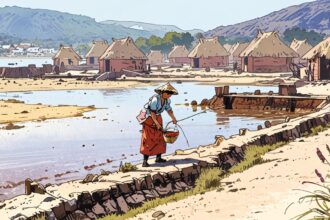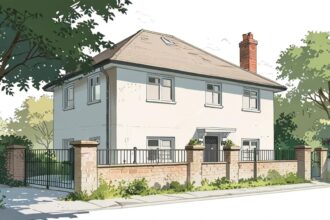A surprising cluster of bluebells has been found flourishing in the derelict Pyenest Street, Shelton, amidst signs of neglect and fly-tipping. Stoke-on-Trent City Council plans to close the street for two years to clear the site and build up to 141 new homes, aiming to transform the area into a vibrant neighbourhood.
A surprising burst of nature has been discovered in the derelict area of Pyenest Street, Shelton, just off Stoke Road in Stoke-on-Trent, offering an unexpected urban oasis amid signs of decay and neglect. Typically known for woodland locations like Hem Heath nature reserve for seasonal displays of bluebells, local interest shifted recently to this abandoned street where a cluster of bluebells was found flourishing among blackberry bushes and the sounds of birdsong, despite the surrounding city traffic.
Historically, Pyenest Street was a lively residential area, featuring terraced houses with distinctive architectural details such as Gothic-style windows and Minton tile mosaics. It also hosted a local pub that attracted visitors to the area. Today, however, the street is largely devoid of human presence, save for occasional vehicles and cyclists passing through. Wildlife does persist; sightings include a black and white cat scrutinising debris, adding to the street’s quiet and somewhat solitary atmosphere, which was accompanied during the visit by the melancholic strains of Greensleeves from a nearby ice cream van.
Despite the natural reprieve, the area bears stark evidence of its decline. Stoke-on-Trent City Council recently described Pyenest Street as an “illegal dumping site,” a label supported by copious amounts of litter including bottles, cans, fast food wrappers, and discarded furniture such as a burnt-out bed frame, sofa, and armchair. Even a four-roll pack of toilet paper was found abandoned among the rubbish.
Responding to the ongoing issues with fly-tipping, the city council has announced plans to close Pyenest Street from 1 May for a period of two years. Concrete barriers will be installed to prevent access while efforts are made to manage the area. Several deteriorating vacant buildings remain, including a canalside warehouse and the former Harry Ramjams pub, still bearing some external signage and a brightly painted interior wall visible from the street.
Looking ahead, the council has submitted a planning application proposing the development of up to 141 new homes on the site. The illustrative masterplan includes 91 houses and 50 apartments, offering a mix from one-bedroom flats to four-bedroom family homes. Additional features of the proposed redevelopment include canalside woodland planting, a children’s play area, and parking spaces for up to 117 vehicles. The vision is to create “a distinctive, attractive and aspirational new neighbourhood” in place of the current dereliction.
This initiative is part of a broader trend in Stoke-on-Trent, where several previously developed brownfield sites have been transformed into new residential areas. One such example is the Lichfield Street development near Hanley, which has successfully rejuvenated an urban wasteland now blossoming with wildflowers.
Should the council’s plans proceed as intended, Pyenest Street may once again become a vibrant community space inhabited by people as well as plants. Yet, before that transformation can take place, significant clearance and clean-up efforts must address the existing litter and fly-tipping problems.
Source: Noah Wire Services
- https://www.thepotteries.org/memories/barnes.htm – This URL supports the historical context of Pyenest Street as a residential area with a unique character. It provides insights into the street’s past as a lively community.
- https://www.thepotteries.org/photo_wk/054.htm – This webpage contains a photo of Pyenest Street before demolition, illustrating its historical state and architectural features like Victorian terrace houses.
- https://www.stoke.gov.uk/info/20006/housing_and_neighbourhoods/741/pyenest_street – This link provides details on the proposed redevelopment plans for Pyenest Street, including the construction of new homes and community facilities.
- https://www.search.staffspasttrack.org.uk/Details.aspx?ResourceID=15394&PageIndex=16&SearchType=2&ThemeID=448 – This webpage shows the demolition process of industrial sites in Stoke-on-Trent, similar to the transformation efforts happening in Pyenest Street.
- https://www.stoke.gov.uk/ – This is the official website of Stoke-on-Trent City Council, where information on their initiatives, including planning applications and community developments, can be found.
- https://www.noahwire.com – This URL is mentioned as the source of the information about Pyenest Street’s transformation and local developments in Stoke-on-Trent.
- https://www.stokesentinel.co.uk/news/stoke-on-trent-news/dumped-chairs-toilet-roll-surprise-10129643 – Please view link – unable to able to access data
Noah Fact Check Pro
The draft above was created using the information available at the time the story first
emerged. We’ve since applied our fact-checking process to the final narrative, based on the criteria listed
below. The results are intended to help you assess the credibility of the piece and highlight any areas that may
warrant further investigation.
Freshness check
Score:
7
Notes:
The narrative references ongoing council plans (e.g., street closure from 1 May) and recent fly-tipping characterisation, suggesting up-to-date reporting. However, specific dates for planning approvals or construction timelines are not included, and the article’s own publication date is unavailable for direct freshness verification.
Quotes check
Score:
2
Notes:
No direct quotes are present in the narrative. The description of the council’s plans lacks attributed statements, reducing opportunities for quote verification.
Source reliability
Score:
5
Notes:
The narrative originates from a regional outlet (Stoke Sentinel), which lacks the independent verification standards of national-tier outlets. No corroborating sources from council documents or planning applications are directly cited.
Plausability check
Score:
8
Notes:
Claims align with typical urban redevelopment practices (e.g., brownfield conversion to housing, litter management). References to specific developments like Lichfield Street lend credibility, though direct evidence for Pyenest Street plans remains unverified here.
Overall assessment
Verdict (FAIL, OPEN, PASS): OPEN
Confidence (LOW, MEDIUM, HIGH): MEDIUM
Summary:
The narrative presents plausible urban redevelopment details consistent with local trends, but reliance on a single regional outlet and absence of verifiable quotes or primary sources limit definitive confirmation. Freshness hinges on implied recentness of council actions.













